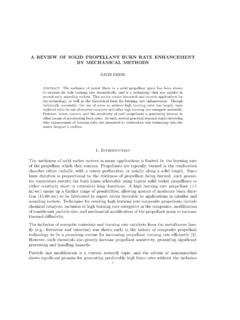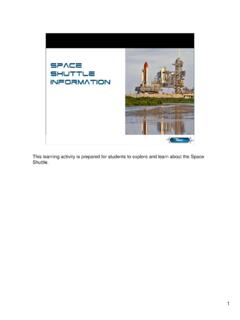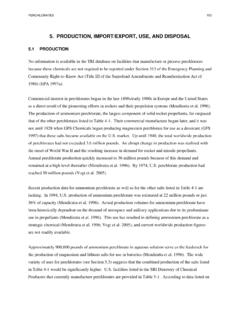Transcription of Rocket Propulsion - Phils Rockets
1 Rocket Propulsion In the section about the Rocket equation we explored some of the issues surrounding the performance of a whole Rocket . What we didn t explore was the heart of the Rocket , the motor. In this section we ll look at the design of motors, the factors which affect the performance of motors, and some of the practical limitations of motor design. The first part of this section is necessarily descriptive as the chemistry, thermodynamics and maths associated with motor design are beyond the target audience of this website. General Principles of a Rocket Motor In a Rocket motor a chemical reaction is used to generate hot gas in a confined space called the combustion chamber.
2 The chamber has a single exit through a constriction called the throat. The pressure of the hot gas is higher than the surrounding atmosphere, thus the gas flows out through the constriction and is accelerated. Combustion chamberThroatNozzle It sounds simple, so why is Rocket science so complex? Well, firstly there s chemistry and the selection of the right reagents from many thousands of possibilities. Then there s the design of the motor to make it capable of withstanding the temperatures and pressures of the reaction while still being as light as possible.
3 There s also the design of the throat and nozzle to ensure that the exhaust velocity is as fast as possible. Putting all these bits together, the average Rocket scientist needs (as a minimum) to understand chemistry, mechanical engineering, thermodynamics, materials science and aerodynamics. Propellants The chemical reaction in model Rocket motors is referred to as an exothermal redox reaction. The term exothermal means that the reaction gives off heat, and in the case of Rocket motors this heat is mainly absorbed by the propellants raising their temperature.
4 The term redox means that it is an oxidation/reduction reaction, in other words one of the chemicals transfers oxygen atoms to another during the reaction (OK chemists, I know that this is not a comprehensive definition but it will suffice!). The two chemicals are called the oxidising agent and the reducing agent. The most popular Rocket motors are black powder motors, where the oxidising agent is saltpetre and the reducing agents are sulphur and carbon. Other motors include Potassium or ammonium perchlorate as the oxidising agent and mixtures of hydrocarbons and fine powdered metals as the reducing agents.
5 Other chemicals are often added such as retardants to slow down the rate of burn, binding agents to hold the fuel together (often these are the hydrocarbons used in the reaction), or chemicals to colour the flame or smoke for effects. In hybrid motors a gaseous oxidiser, nitrous oxide, reacts with a hydrocarbon, such as a plastic, to produce the hot gas. Energy Conversion This reaction releases energy in the form of heat, and by confining the gas within the combustion chamber we give it energy due to its pressure. We refer to the energy of this hot pressurised gas as its enthalpy.
6 By releasing the gas through the throat the Rocket motor turns the enthalpy of the gas into a flow of the gas with kinetic energy. It is this release of energy which powers the Rocket . So the energy undergoes two conversions: Chemical energy to enthalpy Enthalpy to kinetic energy The conversion from chemical energy to enthalpy takes place in the combustion chamber. To obtain the maximum enthalpy it is clearly important to have a reaction which releases lots of heat and generates lots of high energy molecules of gas to maximise pressure. There is clearly a limit to the temperature & pressure, as the combustion chamber may melt or split if these are too high.
7 The designer has a limitation placed on his choice of reagents in that the reaction must not heat the combustion chamber to a point where it is damaged, nor must the pressure exceed that which the chamber can survive. Changing enthalpy to kinetic energy takes place in the throat and the nozzle. Our mass of hot gas flows into the throat, accelerating as the throat converges. If we reduce the diameter of the throat enough, the flow will accelerate to the speed of sound, at which pint something unexpected occurs. As the flow diverges into the nozzle it continues to accelerate beyond the speed of sound, the increase in velocity depending on the increase in area.
8 This type of nozzle is called a De Laval nozzle. ThroatNozzle You will recall that the kinetic energy of a body can be calculated from: 221mvKE= If we consider a small volume of gas, it will have a very low mass. As we accelerate this gas it gains kinetic energy proportional to the square of the velocity, so if we double the velocity we get four times the kinetic energy. The velocity of the supersonic flow increases proportional to the increase in area of the nozzle, thus the kinetic energy increases by the fourth power of the increase in nozzle diameter.
9 Thus doubling the nozzle diameter increases the kinetic energy by 16 times! The De Laval nozzle make Rocket motors possible, as only such high velocity flows can generate the energy required to accelerate a Rocket . In model Rockets the reaction is chemical generally short lived, a few seconds at most, so the amount of heat transferred to the structural parts of the motor is limited. Also, the liner of the motor casing acts to insulate the casing from the rapid rise in temperature which would result from a reaction in direct contact with the metal casing. Model Rocket motors also run at quite low pressure, well below the limits if the motor casing, further protecting the casing.
10 It can be seen that the enthalpy of a model Rocket motor is thus quite low. In large launch vehicles such as Ariane, the pressure and temperature are high, the burn may last several minutes, and the mass budget for the designer is very tight. Designing motors for these purposes is highly complex. Thrust The basic principles of a Rocket motor are relatively straightforward to understand. In rocketry the motor exists to accelerate the Rocket , and thus it has to develop a force called thrust . One of several definitions of force is that: Force = rate of change of momentum If we ignore (for a few paragraphs) any external effects we can say that the thrust is entirely due to the momentum of the propellant , a force called the momentum thrust.









